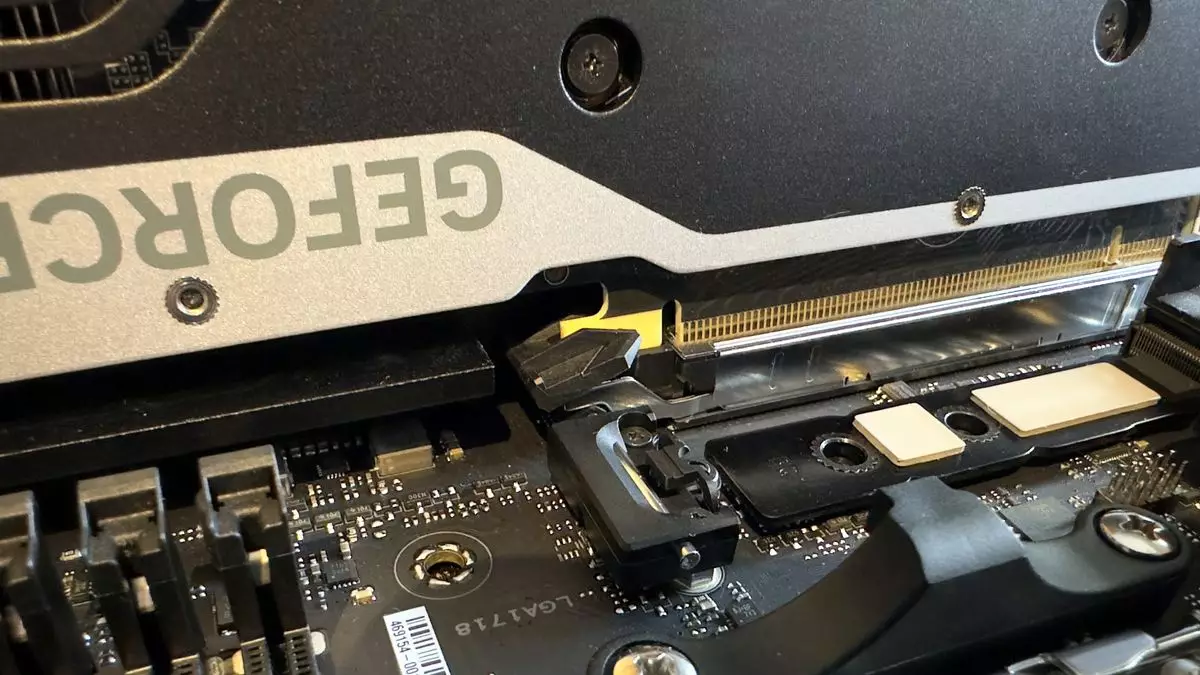In the fiercely competitive landscape of computer components, every misstep can be magnified, and for Asus, the year began with a notable controversy. Disgruntled users reported that the company’s Q-Release PCIe slot was potentially damaging GPU contact pins during installation and removal. This issue, though seemingly niche, caught the attention of tech enthusiasts and industry watchers alike. To mitigate the fallout, Asus promised to cover any damages incurred by these faulty slots, laying bare the fragility of its image amidst harsh scrutiny.
As the dust settled, another player in the field, Gigabyte, seized the opportunity to spotlight the reliability of its own PCIe release system. A post by Aorus, Gigabyte’s dedicated gaming brand, featured a video displaying the installation and removal of a GPU 100 times without incident. To the untrained eye, this might appear as a mere demonstration of technical prowess; however, against the backdrop of Asus’ recent troubles, it becomes a calculated jab at their competitor. Setting Aorus apart reinforces a subtle narrative: their products are not just better; they are more dependable.
Marketing Through Controversy
The subtlety of Gigabyte’s approach deserves recognition; rather than outright attacking Asus, the company opted to leverage the moment to its advantage, illustrating their motherboard’s durability while promoting their products. The Gigabyte Z890 Aorus Elite WiFi7 Ice motherboard is presented as an upgrade for Intel Arrow Lake systems, merging innovation with accessibility. It’s priced competitively, particularly when compared to AMD’s offerings, thereby appealing to cost-conscious buyers, a demographic that often drives sales during times of heightened scrutiny.
Asus’ Q-Release Slim system demands a specific anchoring technique; users must lift the left side of the graphics card to disengage it. This movement can create friction leading to wear on the GPU contact pins. In contrast, Gigabyte’s solution appears sleek and user-friendly, with a straightforward latch mechanism that operates with mere finger or screwdriver pressure. This distinction not only enhances usability but also serves as a clear point of differentiation in a crowded market.
The Performance Debate
Asus has defended its product vehemently, stating that despite the wear, such usage is normal and does not impact functionality or performance negatively. They rationalize that any insertions and removals exceeding 60 will inevitably show signs of wear—an age-old assertion by manufacturers to set consumer expectations. However, when a buyer invests a substantial sum (think $2,000 for the latest GPU), cosmetic damage could taint the ownership experience. A scratched graphics card not only detracts from its visual appeal but potentially diminishes its resale value, an important consideration in an ecosystem driven by upgradability.
Conversely, Gigabyte’s claim that their motherboard remains unscathed after 100 swaps paints a picture of superior engineering and reinforces their message of long-term reliability. This comparison implicitly challenges Asus’ earlier assertions, putting the pressure on them to justify their product’s integrity in light of competitors’ claims. As technical details become public knowledge, the narrative shifts towards ‘trust’—consumers want to feel confident in their purchases, and visible wear and tear could undermine that trust.
Annual Showdown: Principles of Marketing and Consumer Behavior
The tension illustrated in this motherboard rivalry exemplifies larger themes in technology marketing. Brands must navigate not just product quality but also how they communicate about issues as they arise. Gigabyte’s timing and execution demonstrate a keen understanding of strategic marketing; they are not merely promoting a product but positioning it as a superior alternative at a pivotal moment. Narrative control becomes crucial in tech marketing, especially when consumers are forced to question the reliability of a competing brand.
Ultimately, Asus and Gigabyte each navigate their unique challenges. Asus deals with backlash, attempting to maintain customer faith amidst controversy, while Gigabyte capitalizes on its competitor’s stumble. This firestorm of competitive rivalry will undoubtedly influence consumers’ preferences, but it also raises questions about brand loyalty and what actually drives purchasing behavior in such a saturated marketplace.
In these exchanges of strategy, insights, and the finest details of technical reliability, the real winner may not be clear until these products become a fundamental part of users’ gaming experiences. Ultimately, it’s in the hands of the consumer to decide who emerges victorious in the long-term narrative of reliability versus performance.

